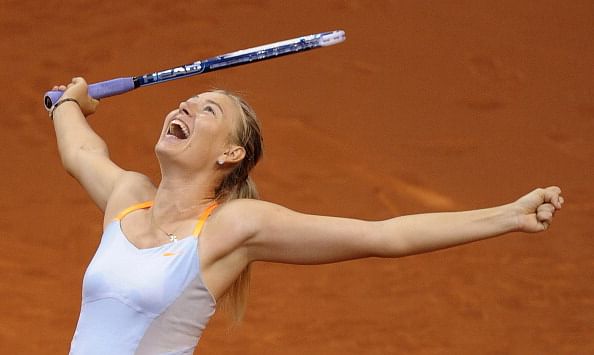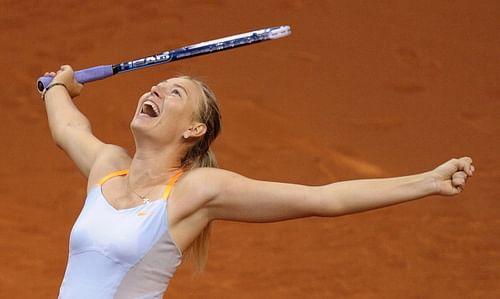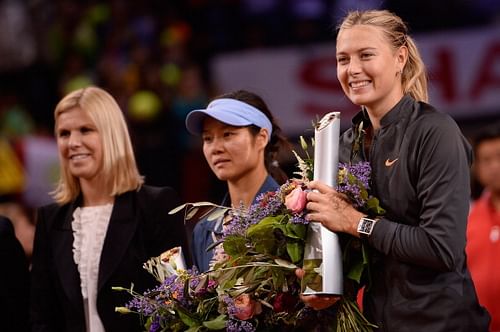
Maria Sharapova: Leaving an indelible mark on clay

Russia’s Maria Sharapova reacts after defeating China’s Li Na in the final of the WTA Porsche Tennis Grand Prix in Stuttgart, Germany, on April 28, 2013. Sharapova won 6-4, 6-3. (Getty Images)
“I feel like a cow on ice. Especially on clay. I don’t play on clay for the other 10 months of the year. It’s not as natural for me.” – Maria Sharapova after her second round win over Jill Craybas at the French Open 2007.
Six years on, one of the world’s most recognized faces, Sharapova successfully defended her Stuttgart title, after having become just the 10th woman to complete a Career Slam with a win in Paris. With a 16-match winning streak on the terre battue, Sharapova now heads the list in winning percentage on clay among active players with an eye-popping .811 (86-20) record.
Sharapova’s renaissance on the red dirt, a surface which had once been her bane, has been impressive. Since her career-threatening shoulder surgery, a process which took nearly ten months off her career, Sharapova has left an indelible mark on her least favoured surface. It hasn’t been easy for the Russian; the rebuilding, relearning, execution and finally a return to the higher echelons cost her two years since coming back in 2009. And it has been the hallowed Roland Garros, which gave the Russian her first major semi-final since her struggles.
For a woman, whose game is built on all-out attack and who did not annex a single clay court title for the first six years on the tour, it can perhaps be attributed to coming of age or should we say, taking steps towards becoming a more complete player. The precocious teenager who stupefied the world in 2004 was content with playing explosive tennis and picking up trophies on the faster courts, which suited her style perfectly. Maybe, the maturity and patience which she gained through her rehabilitation and sabbatical drove her to where she is today. No more puerile ball-bashing on the merciless surface or a needless urgency to finish the point; Sharapova is now far more placid, who plays with her mind as much as she uses her strength.
Let us consider her quarter-final against seven-time major champion, Justine Henin-Hardenne at 2005 French Open:
Sharapova didn’t play a bad match by her standards. But she didn’t know when to pull the strings or decelerate against one of the greatest clay-courters of the game, Justine Henin-Hardenne. The Belgian withstood Sharapova’s early barrage of groundstrokes and quietly absorbed the pace, making confident inroads into the Russian’s game. Maria didn’t have the self-belief to use a down-the-line shot, her defence looked very much penetrable and she rushed to the net time and again only to be flat-footed.
Sharapova looked perplexed many a time and didn’t know which direction to take to crush the return. In other words, her anticipation power looked very much doubtful and her movement was unsteady and sloppy. An aggressive Sharapova vacillated from moments of brilliance to total disarray. Henin-Hardenne took advantage of those moments, used her supremely beautiful backhand effectively and the result was a ruthless straight sets victory for the Belgian, who would be the eventual champion.
Now let us consider her final against 2011 French Open winner Li Na at Stuttgart this year:
The Stuttgart final gave copious evidence to Maria’s now highly-improved defence on the brick dust and the way she was punctuating her game with ripping down-the-line backhand winners was noteworthy. Her anticipation power looked to have increased leaps and bounds. Holding the fort from the back of the court, she lunged for almost every return, which made a huge difference. At 7:36 in the above video, the former World No. 1 simply left the spectators awe-struck by returning a forehand with her left hand and didn’t lose her footing or balance even once. That spoke volumes of her self-assurance.
Also what was striking was how Maria patiently used her much-improved footwork to carve out some amazing point constructions – something which aided her during her first three rounds at Stuttgart. She had been sliding and using a sliced dropshot – not often – but it was certainly helping her. The strategy paid rich dividends in her match against Ana Ivanovic.
The exquisite backhand angles that Maria was creating, especially the one at 2:00, were notable. She backed them up with consistent depth in return. Her serve was particularly effective in the final where she produced 76% first serve in.
Maria has been working rigorously on her serve, which was the worst affected by her surgery and under the tutelage of Thomas Hogstedt, it has been paying off. She has been able to reduce the number of double faults to a certain margin, and her focus on variation and placement has definitely been reaping rewards.

Maria Sharapova of Russia poses with her trophy after winning her final of the Porsche Tennis Grand Prix at Porsche-Arena on April 28, 2013 in Stuttgart, Germany against Na Li of China (C). (Getty Images)
If she has been labouring through three-setters in her first three rounds at Stuttgart, it is because she wanted to take her own sweet time to get used to the feel of clay and polish any kink in her armoury. All those efforts culminated in that mesmerising performance from Maria in the final.
But what should be most satisfying for any Sharapova admirer is the fact that she has now fought off her dirt demons. A much more composed self; her demeanour, attitude and gait now ooze of confidence while playing on such a demanding surface. 2013 is only the third time the willowy blonde has opted to play three tournaments in the lead-up to the French Open, a move which attests her insatiable hunger to climb greater heights even on the dirt.
Sharapova still isn’t flawless – she still sometimes has difficulty in sliding, her serves are not that reliable and she definitely is not of those spin exponents who exhibit amazing flamboyance on clay. But given the unwavering determination and the unbridled passion, the reigning French Open champion has shown, there’s absolutely no reason why she can’t again be one of the front-runners to lay claim to the year’s second slam.